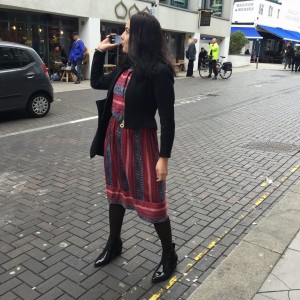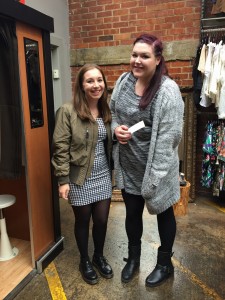
On the 12 of October 2015, The Louis Vuitton exhibition was very overwhelming experience that i’ll never forget. This exhibition in particular you got to see things that you wouldn’t normally see, you got to see the process in which the product was made and this gives you an understanding of the brand, Louis Vuitton himself and the thought process into each product. This makes you appreciate the brand for what it is and what it stands for in a physical and emotional way.
When fashion designers have an exhibition of there new designs for their brand, it’s not only culturally relevant art show for people world wide to come and see but it is also a form of advertisement so the company get to promote the brand. By doing this they get the consumers interested in the product. Knowing the back story how Louis Vuitton started off his company by making trunks and how far he has come since then. Seeing the some of the factory workers actually make one of their products in front of you is not just them constructing a bag by hand, it’s an art form in which you can see how every little detail counts to make this beautiful materials into a master piece. Why not put these products on display? The amount of effort, time and money that has gone into these products is phenomenal just like any other painting or piece of art work out there.
The relationship between fashion and art is difficult to understand in a way because when someone buys art, its called “collecting” but when some who likes to buy clothes, shoes or accessories its called “shopping” and because art can be preserved so it can last a long time they think its different from fashion as the trends are always changing. Louis Vuitton has managed to show both of these things together as one as he has been collaborating with artist director Nicolas Ghesquiere and using his inspiration to create something new and timeless like a piece of art.
Louis Vuitton was originally a trunk maker in 1854 in Paris. His trunks where different so the stood out from the rest as they were the first of their kind to not have a rounded top. We got to see some trunks in the exhibition that were made for certain things like cutlery and camera equipment. Louis Vuitton made this red trunk especially for Albert Kahn who was a French Banker who liked to travel. He marked the products with a “xxx” so that Albert knew that was his trunk. Nicolas Ghesquiere recognised this and wanted to take the past experiences and making them current by adding the “xxx” to the new collection carrying on Louis Vuitton’s legacy. Louis Vuitton in the present has worked with some quirky like Stephen Sprouse when Marc Jacobs was creative director whom he a collaborated with in 2001 and 2009 when they used Stephens graffiti art as the design on the canvas.


As consumers, the Louis Vuitton exhibition is very powerful and overwhelming and makes your experience more enjoyable as it acts on you senses. By doing this it is a form of emotional marketing that appeals to all senses in relation to the brand itself. Using more than one sensory can trigger things in your mind like your feelings and thoughts to create an image in your mind of what the brand is trying to sell to you and get attracted to the brand which is important if you want to sell the product.
As I described in the previous paragraph, sensory components in an exhibition plays a key role. The Louis Vuitton exhibition had four key sensory components out of the five. Sight, smell, hearing and touch. The exhibition is separated into a series of 8-9 rooms, each one different and in each room a different experience. The first room is Genesis of a Collection, showcasing a giant metal dome. It was dark and dull room with wind and sounds machines to make it feel like it was winter. In other rooms you got more visual sensory components. As you went into the next two rooms which were small and dark with the flashing lights. It plays with your mind as it shows how your thoughts can appear like flashes at the speed of light and disappear in an instant. You had the Science of Savoir-Faire and A Tale of Craftsmanship rooms next which were more visual experiences as you got to see how the thought process of each product and the construction of selected products. The final room was my favourite as you got look, touch, smell and hear the products. You got to interact with the product physically and got to feel the soft fur of a coat, the smell of the leather of a handbag or the sound of the sequinned dress moving when you touch it was so satisfying. It gave you a physical connection with the product and made you want it even more.
With all these emotions running around in your head, it will be hard to understand them as you’ll get confused and get confusion confuse with obsession and that can lead you longing for the product. Social media are advertising these images of the brand in which more people can see little bits of the “art show” to get you to come down and experience it first hand. This is a form propaganda, using moving images to capture our attention and our hearts to get us to come see the exhibition.
The show has enlightened me. The thought process that has gone into the products and the exhibition to make you feel that emotional and physical connection with the brand by cleverly using the sensory elements to make you feel something. I feel a deeper connection towards the products because I’ve got to experience the history, the build up, the construction, the finally result of the products and the Louis Vuitton brand itself. Not only just to see the exhibition but to get involved emotionally. This is why Louis Vuitton is such an ionic brand.
 As I came to the end of this project I realised that tights do play a significant part in our lives as people do wear them on a regular basis but they do get taken for granted a lot. The fair amount of people we asked who wore sheer tights during this project told us they didn’t wear the tights because they were fashionable, its because they are practical for cold weather if they still wanted to wear a skirt. They don’t cost that much so they are easy to replace if the ladder, which is why they are taken for granted. Tights can be fashionable if you style them with the right clothes and shoes.
As I came to the end of this project I realised that tights do play a significant part in our lives as people do wear them on a regular basis but they do get taken for granted a lot. The fair amount of people we asked who wore sheer tights during this project told us they didn’t wear the tights because they were fashionable, its because they are practical for cold weather if they still wanted to wear a skirt. They don’t cost that much so they are easy to replace if the ladder, which is why they are taken for granted. Tights can be fashionable if you style them with the right clothes and shoes.







